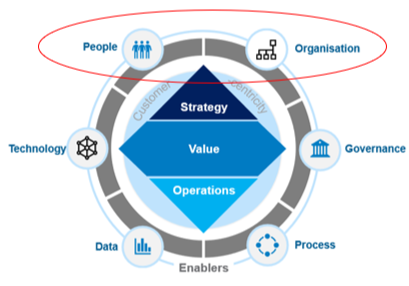How a philosopher can help us change procurement
A lesson about people, positions, power, and change
In the first blog on our adaptive model, we established the argument that there are excellent alternatives to large-scale transformation projects and good reasons for considering the alternatives.
In this piece, we’ll focus on how people and an organisation’s structure might be reconsidered through the lens of the adaptive model.

To frame the discussion, let’s consider one of the big ideas of the little-known, but highly influential 20th century philosopher Karl Popper (1902-1994) – an Austrian who also lived and worked in New Zealand and the UK.
Popper was critical of those who argued the case for large-scale social engineering initiatives and policies. His critique can readily be applied to large-scale organisational transformation projects.
Popper argued that utopian policy engineers determine an ideal goal before any practical action is taken. The design must come first. The means by which that state can be achieved will then materialise.
So, utopian or holistic engineers act with the total end arrangements in mind, seeking to reshape the social whole, bring about far-reaching change, and modify human behaviour so that it conforms to their ideals at any cost.
Popper argued that instead of creating utopia, they create hell on earth.
Rather, Popper says, we should only pursue piecemeal change (which today we might think of as iterative development). More than that though, he suggests we should carry out social experiments on a small scale without revolutionising society as a whole. No single change transforms society, but an ongoing series of iterative changes can, and this is the way society generally prefers to operate. If utopia is eventually reached it will be because the piecemeal method has given us the experience and the evidence to move, piece-by-piece, in that direction.
Popper’s analysis provides a subtle but powerful lesson for organisations and their people. If we apply this type of thinking to how we might improve the capabilities and elements of the procurement function, it is far less likely that you will find yourself at the wrong destination after a very long journey.
The adaptive approach seeks to ensure that, instead of designing a fundamentally different model and embarking on a tortuous journey to get there, smaller, simpler and more flexible changes are adopted. These smaller changes ensure you’re almost always in the right place, and you are never heading in the wrong direction. It applies well to people and organisational structure.
People, positions, and performance
As soon as a job description is written it is out of date. What’s more, no one ever really matches the role 100%. Add hybrid work and the arrival of AI and we probably ought to consider new ways to think about recruiting and managing people, and how we describe their roles.
There is more and more research that suggests that when there is a high level of fit between a role and someone’s personality, the more likely it is they will be highly engaged, more successful and happier.
So, let’s put attitude at the top of the list of attractive characteristics of a potential recruit – on the basis that people with the right attitude are genuinely attracted to the role, learn quickly, are great to work with and get things done. They know how to adapt to an environment they already favour.
We also need to think about the capabilities that will equip the individual and the organisation to deal with the rapidly evolving and complex external environment. Resilience, creativity, empathy and curiosity come to mind. These are largely innate, typically forming part of an adult’s core personality makeup. They are characteristics that can be augmented by capabilities that evolve and develop over time – such as emotional intelligence, adaptive thinking, social intelligence and analytical or critical thinking abilities. People with these qualities in abundance are less likely to find their traditional skillset becoming obsolete as the world changes, and these are the people who will help the organisation to stay nimble and adapt as well.
The gigs are coming
Projects and roles are starting to be supplanted by gigs. A gig can be quite short-term, a slightly fuzzy engagement or an assignment. With gigs, traditional design boundaries are replaced by outcomes and/or benefits focused on group or individual activity.
And… why should a buyer restrict themselves to procurement work, within a single category, when their ideas to grow the top line of the business would necessarily need them to be removed from the traditional procurement paradigm of work? And why shouldn’t we let non-professional buyers undertake sourcing or negotiation work if they have great ideas to do it better? The adaptive model allows boundaries to be questioned, provided the best interests of the organisation remain clear.
Watch this space. Gigs are with us, and they will be around for a long time, so let’s get on the front foot.
Do we still need an org chart?
For some, a new operating model is incomplete without an organogram or organisational chart that clearly articulates – and locks down – who does what, who reports to whom and how the functions interact. With names in each little box. The approach invariably invites political feuds. Again, the adaptive model offers a sound alternative.
Today, rigid, static structures are arguably becoming unsustainable. Taking the procurement example, it’s a fact of life that demand for effort across various category teams rises and falls at different times. So, having fixed resources in each of those teams creates an unnecessary problem.
The matrix organisation, often with a combination of solid and dotted reporting lines, can go some way to negating these bad habits.
Also, some organisations look to resolve the conundrum by having flexible resource pools, particularly covering the market engagement and sourcing phase of the lifecycle, where deep category expertise is less important than process effectiveness and efficiency.
However, complete flexibility is not the answer. For example, we know tendering facilities contracts is very different from software sourcing and there will invariably be a need to inject subject matter expertise at specific points of the process.
So, we are not suggesting that there is no structure or that a laissez-faire approach must be taken. Rather, the adaptive model values responsiveness and flexibility. Some organisations do this well and are typically supported by an open and flexible culture. It will be interesting to observe the role that generative AI starts to play in supporting the need for knowledge requirements in the near future. It’s already the case that we can check our work against what ChatGPT has to offer, and a more proactive deployment of AI in future is a certainty. This could make more flexible organisational structures much easier to implement.
Next, we know that de-layered organisations will be able to change direction quickly. Coupled with the deployment of people with the right innate and developed capabilities, the expression ‘not my job’ will hopefully be consigned to history.
Finally, at a time when post-pandemic hybrid working and the “right to disconnect” are increasingly becoming an infrastructure topic, and as businesses grapple with their bloated office real estate, it has also encouraged the birth of concepts such as ‘I work around my life,’ as opposed to the traditional, reversed position.
The organisations that embrace and adapt to these ways of thinking are the ones that will attract the adaptive, capable people they will need to handle the intensity of change that is now the new normal. They will be able to experiment and make piecemeal changes that are more likely to keep them fit and pointing toward utopia. The rest will simply struggle to compete.





